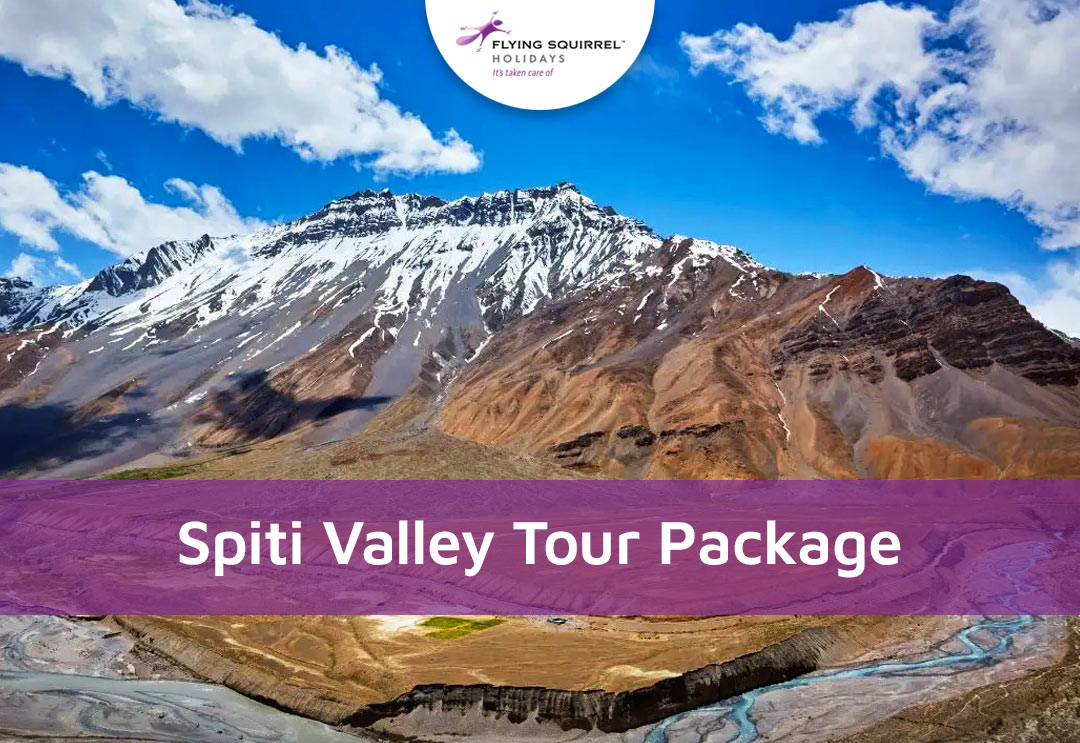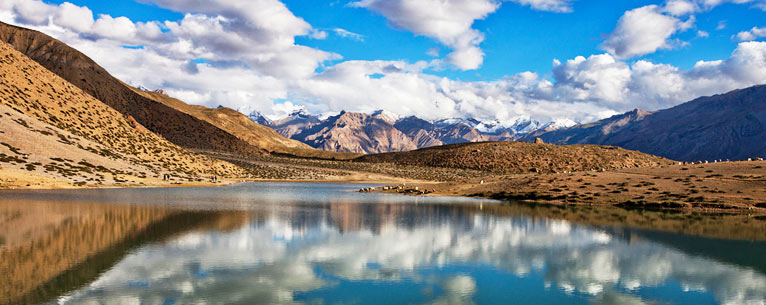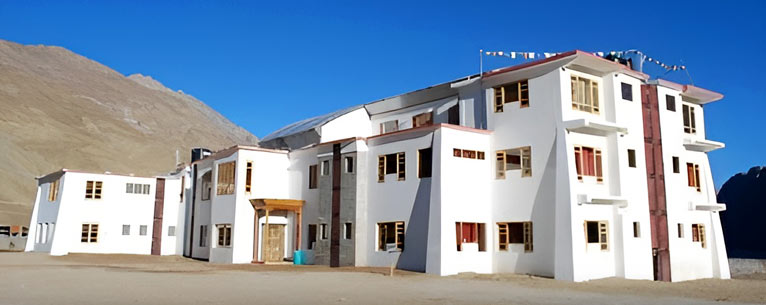
Spiti Valley Tour Package – A Complete Travel Guide
Posted on By Flying Squirrel Holidays
Have you ever dreamed of escaping to a land where rugged mountains stretch endlessly, ancient monasteries whisper tales of the past, and adventure awaits at every turn? Welcome to Spiti Valley, one of India’s most breathtaking yet lesser-explored destinations.
Nestled in the Trans-Himalayas of Himachal Pradesh, Spiti is not just a place—it’s an experience. Whether you’re drawn by its dramatic landscapes, rich Tibetan Buddhist heritage, or thrilling road trips through the world’s highest motorable villages, Spiti has something for every kind of traveler.
But planning a trip to this high-altitude desert isn’t as simple as booking a ticket. The weather, road conditions, and terrain can be challenging, and that’s where a well-planned Spiti Valley tour package can make all the difference.
This comprehensive travel guide will provide everything you need—the best routes, hidden gems, adventure activities, cultural experiences, and travel tips—to embark on an unforgettable journey through Spiti Valley.
Ready to explore one of India’s last frontiers? Let’s dive in!
Why Visit Spiti Valley?

Spiti Valley is unlike any other place in India. Here’s why it should be on your travel bucket list:
- Unique High-Altitude Desert Landscapes – Towering mountains, barren valleys, and azure rivers paint a surreal picture.
- Rich Tibetan Buddhist Culture – Spiti is home to ancient monasteries like Key, Tabo, and Dhankar, offering deep spiritual insights.
- Thrilling Road Trip Routes – Manali and Shimla’s scenic yet challenging roads provide an adrenaline-pumping experience.
- Rare Himalayan Wildlife – Spot the elusive snow leopard, Himalayan ibex, and red fox in the wild.
- Breathtaking Trekking Trails – Explore iconic treks like Chandratal Trek and Pin Parvati Pass.
Best Time to Visit Spiti Valley

Choosing the right season for your Spiti Valley tour package is crucial:
- Summer (May–September): Ideal for road trips, trekking, and sightseeing. The roads via Manali and Shimla are open, and the weather is pleasant.
- Winter (October–April): Best for snow lovers. Experience Spiti, covered in a white blanket, frozen rivers, and winter festivals.
How to Reach Spiti Valley?
Spiti Valley can be accessed via two main routes:
Via Manali (Summer Route)– Open from June to October
- Route: Manali → Rohtang Pass → Kunzum Pass → Kaza
- Description: This is the shorter but more challenging route, featuring dramatic landscapes and thrilling high-altitude passes. The adventure is perfect for those who seek a more rugged and scenic drive.
Via Shimla (All-Season Route)– Open Year-Round
- Route: Shimla → Kinnaur → Reckong Peo → Kaza
- Description: This is the longer but more scenic and stable route, accessible throughout the year, including winter. A great option for those looking for a more leisurely and safe journey with year-round accessibility.
Adventure Activities in Spiti Valley

For thrill-seekers, Spiti Valley offers an array of exciting activities:
- Trekking: Chandratal Trek, Pin Parvati Trek, Dhankar Lake Trek, Kanamo Peak
- Camping & Stargazing: Scenic campsites under the Milky Way at Chandratal Lake.
- River Rafting: Conquer the cold, glacial-fed Spiti River.
- Mountain Biking: Ride through Spiti’s rugged terrain and high-altitude passes.
- Wildlife Spotting: Spot snow leopards, ibex, and Himalayan foxes in Pin Valley.
Hidden Gems of Spiti Valley

Beyond the famous attractions, Spiti hides some extraordinary secrets:
- Gue Mummy Stupa – Home to a 500-year-old naturally preserved monk mummy, an eerie yet fascinating sight.
- Chicham Bridge – The highest suspension bridge in Asia, offering breathtaking views of the deep gorges below.
- Dhankar Lake – A hidden, high-altitude lake accessible via a challenging trek, rewarding visitors with unparalleled peace and stunning views.
- Tashigang Village – One of the most remote and least-visited villages in Spiti, known for its untouched beauty and traditional lifestyle.
- Lhalung Monastery – Nestled in an isolated valley, this monastery is adorned with beautiful murals and an air of spirituality.
- Kibber Wildlife Sanctuary – A less-explored area where visitors can spot snow leopards, Tibetan wolves, and Himalayan blue sheep.
- Demul Village Sky Burial Site – A rare glimpse into the unique Tibetan Buddhist funeral rituals practiced in secluded villages.
Traditional Villages of Spiti Valley

To truly experience the essence of Spiti, visit its traditional villages:
- Langza (The Fossil Village): Known for ancient marine fossils dating back millions of years, evidence of Spiti’s prehistoric oceanic past.
- Hikkim (World’s Highest Post Office): A must-visit, where you can send postcards from 4,440 meters above sea level.
- Komic (World’s Highest Motorable Village): A picturesque village with breathtaking landscapes and an ancient monastery.
- Demul Village: Famous for its self-sustaining, eco-friendly lifestyle, where visitors can experience homestays with locals.
- Mudh Village: The last village in Pin Valley, a gateway to adventurous trekking trails and an authentic Spitian experience.
- Losar Village: The first village on the Manali-Kaza route, known for its traditional Spitian architecture and warm hospitality.
- Gette Village: One of the least-visited villages, offering solitude and panoramic views of the Spiti landscape.
Stay Options in Spiti Valley – Where to Stay for Every Type of Traveler

Spiti Valley offers a variety of accommodation options, catering to different travel styles and budgets. Whether you’re a backpacker, a luxury traveler, or someone seeking an authentic and sustainable stay, Spiti has something for everyone.
1. Sustainable & Eco-Friendly Stays
For travelers looking to minimize their carbon footprint and support local communities, Spiti has several eco-conscious stays:
- Mudh Village Homestays – Experience the self-sufficient lifestyle of Spitian villagers.
- Spiti Ecosphere Homestays (Kaza & Nearby Villages) – Community-run eco-stays promoting sustainable tourism.
- Lalung Homestay (Lhalung Village) – Stay in traditional mud houses with solar energy facilities.
2. Luxury Stays in Spiti Valley
While Spiti is known for its raw beauty, a few luxury accommodations offer comfort and premium services:
- Hotel Spiti Heritage (Kaza) – A high-end hotel with breathtaking views and modern amenities.
- The Grand Dewachen (Kaza) – A luxury boutique hotel blending Tibetan aesthetics with contemporary comfort.
- Norling Homestay (Tabo) – An elegant stay with traditional architecture and premium hospitality.
3. Mid-Range & Budget Guesthouses
For travelers looking for comfort without breaking the bank, mid-range hotels and guesthouses are a great choice:
- Zostel Spiti (Kaza) – A popular option for budget travelers with private rooms and dorms.
- Tara Guest House (Kaza) – A budget-friendly, family-run guesthouse known for its hospitality.
- Snow Lion Guesthouse (Tabo) – A cozy and affordable guesthouse near Tabo Monastery.
4. Backpacker Hostels & Affordable Stays
For solo travelers and backpackers, Spiti has several affordable and social stay options:
- The Wanderer’s Nest (Kaza) – A perfect spot for meeting fellow travelers, offering bunk beds and common areas.
- Norbukhang Homestay (Langza Village) – A budget-friendly stay in one of Spiti’s most inhabited villages.
- Spiti Backpackers Hostel (Kaza) – A basic yet cozy option with an active backpacking community.
5. Monastery Stays – A Spiritual Experience
For a unique and spiritual experience, consider staying at a monastery:
- Key Monastery Stay – Experience monastic life with simple accommodations and a serene environment.
- Tabo Monastery Guest Rooms – Stay in a 1,000-year-old monastery and immerse yourself in Buddhist teachings.
- Dhankar Monastery Stay – A rare opportunity to stay in a monastery perched on a cliff.
Confused about permits, stays, or routes? Let our Spiti pros guide you.
Handcrafted Spiti Valley Tour Itinerary

Day 1: Arrival in Manali/Shimla
- Arrive in Manali or Shimla and spend the day acclimatizing.
- Explore local attractions such as Hadimba Temple (Manali) or Mall Road (Shimla).
- Prepare for the upcoming journey through Spiti’s rugged terrain.
Day 2: Manali to Kaza / Shimla to Kalpa
- Begin the road trip to Spiti, passing through lush valleys and steep mountain passes.
- If traveling via Manali, cross Rohtang Pass and Kunzum Pass before reaching Kaza.
- If traveling via Shimla, enjoy the scenic route through Sangla and Reckong Peo, staying overnight in Kalpa.
Day 3: Exploring Kaza – The Heart of Spiti
- Visit Key Monastery, one of Spiti’s most iconic monasteries, perched on a hill.
- Explore Kibber Village, famous for its high-altitude landscapes and wildlife sightings.
- Walk across Chicham Bridge, Asia’s highest suspension bridge.
Day 4: Traditional Villages & Cultural Immersion
- Visit Langza Village, known as the Fossil Village, where marine fossils can be found.
- Explore Hikkim, home to the world’s highest post office.
- Travel to Komic Village, the highest motorable village in the world.
Day 5: Ancient Monasteries and Spiritual Retreats
- Drive to Tabo Monastery, one of the oldest monasteries in the Himalayas, dating back over 1,000 years.
- Trek to Dhankar Monastery, dramatically perched on a cliff offering breathtaking views.
- Visit Lhalung Monastery, a lesser-known but spiritually significant monastery.
Day 6: Chandratal Lake – The Moon Lake
- Drive to Chandratal Lake, one of the most stunning high-altitude lakes in India.
- Enjoy an evening of camping and stargazing under the crystal-clear Himalayan sky.
- Experience the surreal reflections of the mountains on the lake’s pristine waters.
Day 7: Pin Valley National Park & Adventure Activities
- Explore Pin Valley, home to snow leopards, ibex, and Tibetan wolves.
- Visit Mudh Village, the last village in Pin Valley, known for its trekking trails and scenic beauty.
- Engage in adventure activities such as river rafting in the Spiti River and mountain biking on rugged trails.
Day 8: Hidden Gems of Spiti
- Visit Gue Mummy Stupa, which houses a naturally preserved 500-year-old monk mummy.
- Hike to Dhankar Lake, a peaceful yet challenging trek above Dhankar Monastery.
- Discover Tashigang Village, one of the most remote and least-visited spots in Spiti.
Day 9: Leisure & Local Life in Spiti
- Experience a traditional homestay to get a taste of Spitian hospitality.
- Take part in local cooking sessions to learn about authentic Himalayan cuisine.
- Shop for handmade woolen items and local handicrafts as souvenirs.
Day 10: Return to Manali/Shimla
- Bid farewell to Spiti and drive back to Manali or Shimla.
- Capture the last glimpses of the stunning landscapes before concluding your journey.
Need help crafting your Spiti itinerary? We’ll call you with custom ideas.
Essential Travel Tips for Spiti Valley

- Permits: Inner Line Permits are required for certain areas.
- Altitude Sickness: Acclimatization tips for high-altitude travel.
- Packing Essentials: Layered clothing, medicines, and sturdy shoes.
- Connectivity: Limited mobile networks; BSNL works best.
- Sustainability: Follow responsible travel practices to preserve the fragile ecosystem.
Spiti Beckons – Are You Ready?
Spiti Valley is not just a place; it’s an adventure waiting to be explored. Whether you’re chasing thrills, cultural immersion, or moments of solitude, this Himalayan wonderland offers an experience like no other. With its stunning landscapes, rich Buddhist heritage, and exhilarating journeys, Spiti is a destination that stays with you forever.
Ready to embark on your Spiti Valley adventure? Book your personalized tour package today, and let us help you craft an unforgettable Himalayan experience.
Talk to our travel specialists today! We’ll help you plan the perfect Spiti Valley tour package based on your interests and budget.
Call us at +91 33 40525777 / +91 833 697 8737
Email us at [email protected]